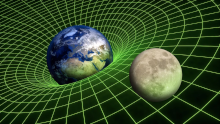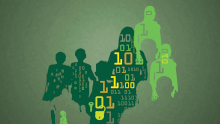April 2022 (Original ≽)
Time »
Question: What is "time"?

Answer: Physical "time" is a measure of events. Like the height of a prism that, as a multiplier with a base, participates in measuring its volume, or the ordinate (y), which with the abscissa (x) determines the position of the point A(x in the coordinate system (Oxy).
Intervals of physical duration, periods of time, we measure by events. It is not possible otherwise, and it is absurd that the greatest such precision is based on random outcomes (Atomic clocks). Consistently, in information theory (Space-Time) the number (amount) of random events defines the flow of time. This makes time and information inseparable, because each of them is a kind of "amount of uncertainty".
The slower course of time of the special theory of relativity (Einstein, 1905) tells us about the "lack of events" for the relative observer, the one who observes the inertial motion at a constant speed (v = const.) of another system. The self-observer (proper), the one who travels with the system, will not notice his lack of events. The ratio of the units of duration of relative and proper (self-observation) is γ = 1/√[1 - (v/c)2], the Lorentz gamma coefficient which contains just the value of c ≈ 300,000 km/s, the speed of light in vacuum.
As for my information theory, I emphasize from the above the "confusing" conclusion that part of the proper (own) phenomena is not in the domain of relative observations. Or more importantly, that abstract evidence of additional dimensions of time, based on geometry without metrics (topology), which I found together sometime in the early 1980s, should be considered more seriously and concretely.
The first step towards physics would be the (hypo) thesis that force changes probabilities. According to the "probability principle", which I considered to be the universal more frequent occurrence of the outcomes with higher (mathematical) probabilities, every physical system will spontaneously develop towards more certain states, or will try not to change its current state until some force acts. Understanding the world in this way, the inevitable conclusion is that the "amount of events" must have something to do with the law of inertia.
Compton's effect, more precisely its new explanation (Scattering), would be the missing link in the continuation of the story. To the known that the amplitudes of the wave function determine the probability of finding an observable in the measurement process, we now add that the wavelengths of the particle-wave speak more about the probability densities of space-time in which it arrives. And it would like to go where those probabilities are higher, that is, where its wavelengths will be smaller.
According to the new, additional explanation of Compton's scattering, the photon moved in a path of shorter wavelengths before colliding with an electron, because it saw its path as more probable, and only forced by an obstacle to turn to (from its point of view) a less probable path.
Similarly, to change the velocity of the above-mentioned inertial system, it is necessary to change its v, i.e. kinetic energy Ek = mv2/2, where m is its resting mass (proper), which means again the effect of some force. It is enough to take γ ≈ 1 + (v/c)2/2, in conditions of speeds negligible versus the speed of light. The kinetic energy of classical mechanics arises precisely with this increment of the Lorentz coefficient, given to it by velocity and, on the other hand, the well-known Einstein equation E = mc2.
All this became related to (new, my) information theory simply because I embarked on testing determinism by denying it, taking as a starting point that information is the basic tissue of the universe (space, time and matter), and that uncertainty is its essence.
Attraction »
Question: Slowing down time is appealing?

Answer: Yes, to be more precise, places with a slower flow of time are attractive to the body that perceives them as such. This is one of the consequences of Einstein's general relativity, but also the theory of information from the attraction of a smaller "amount of uncertainty" (Time).
In my book Space-Time you will find (1.129) Einstein's field equations with his original simple explanation, that the geometry of space defines physical matter and vice versa, matter defines the space. He found the idea in Riemann's tensor development of the curves of space, which was again found by Gauss (Theorema Egregium, 1827), to remain unchanging, invariant to rigid, isometric transformations (Inflexion). Because of it, for example, the cartography of the globe cannot be accurately transferred to the plane.
Thus, Einstein saw gravity not as a force, but as an internal property of space created by the presence of matter. It changes the "perception" of the subjects about the environment, about the "objective reality" through which the body moves. Spontaneously, by inertia, it "floats" in space-time of the gravitational field following its own (imposed on it by the presence of energy-matter) observations of the shortest distances.
In Einstein's field of objects, something similar to Snell's law of refraction of light happens (Speed of light). The waves turn into an "optically denser" environment, in fact towards places with lower speeds, trying to cross the roads they have to in the shortest time. In the gravitational field, by analogy, bodies also adhere to the same "principle of least action", otherwise long known to theoretical physics.
In the same book (Space-Time), I listed Euler-Lagrange equations (Theorem 1.2.10), which are an expression of the principle of least action and whose solutions are all known today types of physical movements. You will find a slightly different treatment of the same E-L equations in the book Minimalism of Information (Theorem 2.4.2), from which Christoffel symbols of the tensor calculus are derived, and then Einstein's famous equations themselves.
Thus, the equations of the general theory of relativity are feasible from the principle of least action. This is a seemingly very different way from the original Einstein's (1915), and is an important result for information theory. Because the principle of least action is a consequence, better to say it is an equivalent to the principle of saving communication, which is again a consequence, or rather equivalent, of the above (my fictional) "probability principle", according to which most likely outcomes will most often occur.
The consideration of free fall in a weak gravitational (Newton's) field also contributes to the unusual harmony of these performances. Then, if the satellite's orbit can be considered inertial motion (Space-Time, p. 58 et seq.), it can be shown from the change in the frequency of light inside that the observer outside the gravitational field observes time dilation and contraction of radial lengths. Moreover, from such considerations one can obtain the Schwarzschild metric, otherwise derived for a centrally symmetric gravitational field from Einstein's equations.
This metric, on the other hand, shows how gravity "pulls" toward where time flows more slowly. This closes the circle of proves, from the principle of the highest probability, that it is more likely to happen more often, through the principle of least information, because it is more likely that is less informative, to the conclusion about the attractiveness of the space-time of less "quantity of events", with which we come (again) to the Einstein's gravity.
Stretching »
Question: Does gravity also stretch information as you described it in special relativity (Time)?

Answer: Yes, these processes are very similar. Already in Schwarzschild's (1916) solution of the Einstein's so-called general equations (Space-Time, pp. 62-65), for centrally symmetric gravitational fields (Earth, or Sun), time slows down at lower points.
From the metric (1.137) follows the ratio of the units of the lengths of relative and natural time t'/t = γ, where this "gamma" defines the reciprocal "gravitational potential", precisely γ = 1/√(1 - rs/r), where r is the distance given point from the center of the field, rs = 2GM/c2 is the Schwarzschild radius, the radius of the "event horizon", the boundary sphere of the "black hole" created by a body of mass M, and G ≈ 6.674 × 10-11 10-11 m3 kg-1 s-2 is gravitational constant, and c ≈ 300,000 km/s speed of light.
I use the same notation γ in the case of special and general relativity, because I have long had a derivation of the second from the first (e.g. Space-time, Theorem 1.4.4, but also before), which other authors have recently begun to discover in their own way (The Relation between). This is a formalism of the same application of the effects of slowing down time, on the one hand applied to uniform motion by inertia, and on the other hand to the action of gravity. It talks like the way apples are collected and other countable values, about the results in each of these applications equally useful, very precise, and yet quite special.
Lorentz's coefficient of "gamma" of special relativity with this, in general theory, has a common meaning of the measure of the amount of uncertainty. As with Hartley's information (logarithm of the number of equally probable outcomes), it is the "quantity" for the mentioned gravitational potential. But that's not all.
It has been shown that bodies in a gravitational field have their own present that are not equal to all observers or are not fully visible. In addition to this, there are other ways to achieve the same result. I mentioned one in the article about dimensions, the other mentioning that it takes time for light to reach from the end to the end of the body, which means that the ends are not simultaneous even for one's own observer.
Note here that the object of observation in a gravitational field can be simultaneous, and in separate parallel realities of another observer. Simultaneous parts of the first can be quantum entanglement (Gloves) which in that sense can make a "phantom action at a distance" from the point of view of the second. In any case, it will not be communication between, for information means time.
In addition, this makes it easier to see the need for force (change of kinetic energy) in order for a given body to happen in a different "parallel reality" in relation to the same relative observer. That it is the force that changes the amount of perception, i.e. the above-mentioned "amount of uncertainty", and therefore the information and probability. Force changes the perception of the present, which is in (my) theory of information in a way that it changes the present itself.
In all these "stretches of reality", we note, "physical time" also appears. We have this from determining the passage of time using the amount (number) of random events. From the point of view of relative observers, the action of forces will suppress the current uncertainties of a given body in some others, the given times in some other, here, for example – due to the principled minimalism of information. Repressed, muted, covert information is absent and appealing, as is repressed uncertainty, or the time.
Now that we know why these repressed realities are retreating as "pseudo-realities" after "real realities" (information theory), we see that the opposite is also happening. Realities that are real to one, to the another can be pseudo, so attraction, let's say "withdrawal", is mutual. This brings us in a different way to my previously mentioned speculation about "space that remembers" (Growing), that is, about the action of the past on the present, as a special kind of pseudo action on the current reality.
Gravity »
Question: So, what is the gravitational "force" by information?

Answer: First, gravity is an internal property of space and time that changes the "perception" of the subject's environment with matter, primarily about the lines of the shortest distances between events. This is closest to Einstein's (1915) interpretation, from the point of view of information theory.
Secondly, gravity is the spontaneity of the principle of minimalism of information and in that sense "force". The deficit of uncertainty occurs by slowing down time and is so attractive, because events will spontaneously move towards less informative, more probable ones. It is also an informatic like Attraction and, due to the principle of least action, but also by the mentioned interpretation of physical time it is relativistic.
The third is Stretching. It touches on "parallel realities", bypassed in the previous two, more precisely the retreat of "fictitious present" which general relativity ignores physically, although it itself arose from geometry which implies over-space within which a given space is curved. Just as a lie is more appealing than the truth, but it is weak (Obsolescence), so is fiction versus reality.
The presence of fiction (pseudo-reality) makes objects within the gravitational field more attractive. I'm talking about a literal, physical phenomenon and the resulting movement. It is created by the "force" of the principle of minimalism, which also opposes the unification of fictitious and real relative reality, making their stretching real. Otherwise, excess (disclosed) information would be manifested.
A similar "mechanism" opposes the discovery of pure truth. The allure of untruth overcomes the power of truth, and the dance of these two tendencies survives as the ripples of seawater. It is the "stronger" parts, which manage to weigh down, that push the "lighter" ones upwards, and then their roles change. As well as the defense of a once accepted lie that overcomes the acceptance of a new truth (Dogma), which are situations in which each of us can be caught.
This is how "blindness" to the "shortest paths" of bodies affected by gravity is formed. Avoiding excess communication, in theoretical physics we would say interactions – consistent with the principle of least action, the body that the relative observer sees adheres to its fictions as well. Gravitational trajectories flow through larger pseudo realities minimizing the exchange of information its participants.
Such seemingly different theories of gravity "are multiplying and becoming more accurate" the more exact they are. Mathematics is of such a nature, the more practical the more abstract it is, and on the other hand "schizophrenic" in the sense that it reveals more and more of its faces about it.
Withhold »
Question: Do you have any corrections about entropy after about 10 years? (A colleague asks me about texts like "Information & Inertia" from 2016 and earlier, given the findings over the next decade.)

Answer: I have often written about entropy, here recently (Entropy), and it is almost impossible to add anything new. Attempts by others on this topic are ongoing (Reports, 2017), for now without significant progress.
I generally do not give up on the standpoints of my mentioned texts, primarily because I am without good arguments that they are not accurate, but because I am convinced that they are OK. The situation now for "for" and "against" is unresolved, it seems to me, but I can't easily give up on the first one until I push the matter to the end, let's say to some contradiction.
The official position of physics today is invariant entropy, that it is relatively equal to its proper (own), and that what we see is all that can be seen, that there are no parallel times. However, in addition to the above description of gravitational attraction (Gravity), when there is "muted" information of the body in the gravitational field, in relation to the observer outside, there will be "total" information greater than visible. Furthermore, the surplus of information corresponds to the deficit of entropy, so the relative entropy of the body in the field is smaller.
I know this is not crucial evidence, nor is it the story of the "Icy Sun", nor the higher temperature towards the centers of galaxies and the radiance of energy from there, which according to the second law of thermodynamics, that heat spreads spontaneously from warmer to colder, towards higher entropy) could mean that in a stronger gravitational field there is less entropy. But these are the arguments that make this (hypo) thesis still valid.
If the entropy of gravity were higher and that was the reason for the attraction (spontaneous growth of entropy), the planets would try to leave the orbits or would gravitate towards the Sun in a way that could be felt on Earth. We do not have such confirmations yet.
On the other hand, we have a theory according to which information is equivalent to action (energy × time), for which there are the smallest packets (Packages), so relatively slower times will correspond to relatively higher energies, and this is what happens. Let's distinguish this argument of increasing energy by slowing down the flow of time, say from the before mentioned simple laziness, or inertia from binding to a larger range of (parallel) time, even though they come out the same.
As there are no energy losses from "this side" of reality due to the presence of "the other side" of the same subject of the gravitational field, because the perception of "reality" relative to one's own observer changes, the law of conservation of both energy and information applies. However, there remains a latent presence of one's own information, which the relative observer must count on – which can be measured.
This pseudo-reality, which has a supplement in the form of latent information of objects in the gravitational field, speaks of a lack of entropy (by the logic that more information means less entropy), and we can reach the same in a slightly more classical way. The entropy of Boltzmann gas is higher when the molecules are evenly distributed. The same vessel with weightless gas will have a more even distribution of molecules than on the ground (where their weight will make them at least a little denser towards the floor), down the entropy can be lower also according to the Boltzmann.
Everything said here applies to the special analogously as it applies to the general relativity. And due to the lower relative entropy of the body in the mobile system, it could (spontaneously) remain in its state of motion. It is a way to understand the law of inertia based on the law of spontaneous growth of entropy. But I consider the law of spontaneous decline of information (minimalism of action) to be stronger than this, so the questions of entropy remain more open to me.
Deceleration »
Question: What can I say about "Hubble tension", about the disagreement about the age of the universe (which is expanding faster than it should be)?

Answer: State in the study the newer "hypothesis of inhomogeneity" of the universe on a larger scale, and if you really want, I can give you one of mine, unknown to the general public.
It is also a hypothesis, which speaks of slowing down the present and for now the reserve (Growing), because I do not really need it in information theory. It is interesting because of the simple explanation of the duration of the universe, inflation in its early period, and its expansion in general, but also the interpretation of disagreements about the age of the universe.
Because the amount (number) of events determines the speed of time including of the our present, and because of the spontaneous growth the substance’s entropy and the melting of that information into space, the time of a given event from the past seems to flow faster. On the other hand, galaxies are moving away with relativistic slowing down their time in relation to us, and compensating by its movement the first time-differences. Compensation is theoretical, for now, so that by choosing the "right" speed, it is possible to achieve exactly those controversial eight percent of disagreements.
The very idea of slowing down the time of the present, as incredible, strange, is as grateful, and it is not (visible to me) in contradiction with the theory of information, so I keep it as an important reserve. I would like to hear about the measurements of the Doppler effect of a star orbiting a given place from a distant galaxy, in order to test this hypothesis and its possible further adjustment.
The same speculation entails changes in some of the constants of physics with the aging of the universe. Such is, for example, the slowing down of the speed of light in a vacuum, which again agrees with the early inflation of the universe, but it is "enough" for itself to explain its expansion. These quotation marks emphasize that every correct theory is self-sufficient and is in line with every whole and every part of any other correct theory.
Domination »
Question: What forces people in dominations, to control others or submit to someone?

Answer: Sigmund Freud and his followers would say that it is sex, or many would talk about various instincts, today it is popular to reduce "power" to synapses, and I am lonely in these stories with "information theory" (private).
Question: Hey, listen, to "private theory", is there such a thing in science?
Answer: Any originality is initially private. And science today is a job, a prestige, an institution. Teamwork, almost without exception, so it can really seem like the real and only face of science. This brings us back to the question of authority, domination and obedience.
Question: How?
Answer: Nature is ruled by a mild but persistent "principle of information minimalism". Its processes would (spontaneously) develop towards states of less information (higher probabilities), less communication (less interaction), to be inert and follow the "principle of least action". The essence of information is uncertainty, and its lack becomes order, regularity, legality, security, efficiency.
The same "force" of minimalism moves the ruler to rule, the subjects to submit, the masses to seek justice from the state, scientists to subordinate to institutions and authorities, but also to individually seek order in cosmos to avoid uncertainty.
Let's add that this "force of minimalism" is the one that slows down our time. We discover that the spontaneous growth of entropy applies to matter and unnecessarily to other types of physics particles, then that increasing entropy reduces information, that the law of conservation of information applies, and all the substance of the universe melts, very slowly but persistently, into space.
Time travel »
Question: Explain to me (once again) time travel?

Answer: Simultaneous events can be quantum entangled, and then communication with one of them (measurement) affects the others. But in 6-dimensional space-time from this theory (Dimensions) the subjects to whom such attachments refer are not necessarily from a given (our) 4-D reality, when their changes may seem like "Spooky Action at a Distance".
For subjects of simultaneity, there is no mutual travel through time, but there is a change of place in space. Such, however, other subjects may observe at different moments and at different times. An example is a photon that changes its place and time in relation to the observer, but the particle-wave of light itself does not have time.
By moving from event to event at the speed of light, Einstein defined simultaneity in his special theory of relativity (1905). These are not the same for different coordinate systems in uniform (constant speed) inertial motion. He demonstrated this with the help of a passenger in the middle of a moving car who was ignited a match just as they were watching him from the embankment next to the train. The light of the match for the passenger reaches the opposite walls of the compartment at the same time, but not for the observers from the embankment, because the train moves towards the front beam while the rear part of the wagon catches up with the opposite one. This was about the speed of light in a vacuum that does not depend on the speed of its source.
The observer, that is, his present, traveling through his time, sees different places and "times" of that photon, aspects of one simultaneity. When he communicates with what has been said, he perceives the photon, adopts its information, the observer influences its simultaneity, all that present, in fact all the photon's past from the observer's point of view. By perceiving only one part of the unique simultaneity, we destroy (change) everything.
The "past" of light is the past of the observer. By absorbing light, destroying its information, the light itself is all destroyed, but its history remained "written" together with the observer. These moments are crucial for understanding time travel (which I talked about earlier). In other words, what we consider "temporal causality", a sequence of supposedly causal events with the development of someone's "now", is mostly the path of the most probable events over time.
When the bearer of the course of an event communicates with a single simultaneity – he will disrupt everything, including its parts that he would consider his past, which would disrupt his past. Then the history of the observer becomes different, he is no longer exactly the same as the previous one. I know it sounds "silly", but think that none of us has ever been exactly the same as before.
By changing the past, the identity of the subject changes, but there is no chance that such a person will return to the old identity. The latter comes from the immeasurably less countable infinity of "discretion" (Recursion), which is a series of perceptions within a 4-D reality, from the infinity of a "continuum" such as the 6-D space-time of all possibilities. There is zero probability, on the real axis, in a random way, drawing a predetermined real number. The same zero probability is at least one draw of a pre-given real number after an infinite (countless) attempts!
The consequence of the law of probability is the zero chance of accidentally returning to a chosen event of one of the pasts, even if only one of the countless of us – after a long series of attempts, and even if such attempts are followed by moments of existence of all of us. If we were to randomly return to someone's past, it would always be a past that is not exactly like that of any of the present times from which we would go there.
I'm not talking here about some technology that might overcome the otherwise fundamental randomness of the space-time information theory.
Lateral »
Question: What do you mean by "side time" (from private correspondence)?

Answer: The information theory I am developing implies some options and their objectivity. First of all, we note that the former can do without the latter.
When a hunter hunts game with cunning and tools, relying on knowledge and skills, he (un) consciously believes in the diversity of data and their powers of the subjects of nature. We communicate because we don’t have everything we need, nor can we definitely have it, and analogous and physical substances interact. So, there are options that we do not have and depending on the circumstances they are available to us. These elections would be false, illusory, if this world were deterministically organized, such that all "choosing" are predetermined once and for all.
The world can be all causal (consequential), and the subjects believe that they have "options". Moreover, their "possibilities" can be relative, unequal in different individuals, that no one has them in the same quantities, also in layers, and again the participants unaware that all "rights to choose" are just an illusion.
The objectivity of the options would be a step further in that direction. This would mean that there is material evidence of entering different worlds by choosing, as opportunities more or less change the reality, the universe. Such objectivity is the kind I am working on in this information theory (Dimensions). The evidence would be "detours" through the "lateral times" I have already written about (Solenoid), but not only that.
Progress »
Question: Emancipation or tradition?

Answer: Both, but the question is in what quantities.
Male behavior (bipolar species) is mainly profiled by evolution, continuing the existing characteristics of the species for its further survival or progress. The unpredictability contained in information theory agrees with this prediction. For example, in the case of the same (average) intelligence, the variance (scatter) in men is higher than in women (Variability in General Intelligence), and mostly the male propensity to risk (Differences in Risk Propensity) is higher. I have often written about it (Emancipation), although unnoticed, and now is the opportunity to repeat the parts.
The species adapts in this way, we believe. New temptations are being tested by the method of trial and error (the so-called Monte Carlo, probability theories), i.e. predominantly male rushing, or let's call sacrifices. Those new and favorable behaviors could pass. Adopting adaptation is not a necessity of this method and not all species manage to survive – an environment that is constantly changing.
That is the question of "emancipation" that I am talking about. It discusses the ability of the species (society) to move to new ways of living and their survival. That is why a larger share of women to whom the notion of emancipation refers, but in this sense the same is true for the rest of the male population, usually within its majority, and would like to be "unadopted" and "left behind in routines".
The sub-questions of this explanation would relate to the opposite of hesitation. Because nature does not extend uncertainty and through evolution from the beginning does not favor originality and variability, for example. Why, for example, did it not take a different path and develop greater adaptability to change and intelligence of its products? These are the real questions for a theory that would challenge "information theory" (mine), to which it has answers.
Uncertainty is the basis of the problem of progress we are talking about, and it is infinite, unattainable and unconquerable territory from the top, unlike the discretion of information, the lower availability (Packages). There is no set of all sets, there is no set of all theories, there is no end to the march towards uncertainties.
That was the "bad news" of this theory, and the "good news" is the presence of the principle of saving information. The cosmos doesn't seem to like to be overpowered (Ruler), I paraphrase, without its uncertainty, nature can't, but it doesn't want to show it off either!
Question: Wow! The cosmos doesn't like to be overpowered, you say?
Answer: Isn't that a rather obvious consequence of the "principle of information minimalism". The fact that the legality of the issue has never been noticed before is not surprising, because the quoted is also a new. More precisely, the already known "principle of least action" in theoretical physics, now is discovering in the information environment. We learned that action is the equivalent of information, and the essence of information is uncertainty.
Nature does not like the realization of uncertainty, that means: neither the emissions of information, nor communication. But its resistance to the unknown is as persistent as is so mild that mathematicians and scientists have not noticed it for centuries. And that is that. We dealt with the theory of probability and took it for granted that more probable occurrences occur more often, and the discovery that the smaller the information, the more certain the occurrence comes through. Then, it could not last long to hide that more informative phenomena are more incredible and rarer.
That is why more intelligent forms of living beings are rarer than non-intelligent ones, and inanimate beings are more common than these. Simple physical substances are in excess of "free will". The ultimate "least action principle" of physics applies to more cosmic subjects than others. In order to master nature, one needs to master its uncertainty (Ruler), and these principles say that the nature opposes it.
However, by possibly spending uncertainty, learning and said mastery, in the essential sense of information – we would be left without it. Fighting against "principled minimalism", we would fall into the trap of respecting it.
The Truth »
Question: Is the truth strong but unattractive?

Answer: When in exact science we "prove" that something cannot happen, it does not happen, and the opposite is similar, what is "true" happens. In short, there is the content of the term "truth" within the theory of information (mine), otherwise a very controversial concept (What Is Truth).
In other words, information is true, in the same sense, because it is equivalent to physical action. Deception, manipulation, cunning, or simply a lie, non-truths are, or more precisely, truths are suppressed (Dualism of lies). Consistent with that, truth is "stronger" than lies, in the sense of more realistic, more permanent (Conservation), but in excess it is repulsive, due to the principle of minimalism of information. Again, on the other hand, due to the same principled economy of information, lying is more attractive than it.
Question: Tradition, what is it and why? (from a similar correspondence on information theory)
Answer: A lie is covert, coded information and, due to the sparseness of information of nature in general (more likely outcomes are more common, and such are less informative), it is attractive. But precisely because of that deficit (information that is equivalent to physical action), the lie is weak and in the real conflict with the truth, the truth wins.
The lesson is that tradition, together with dogmas, can be the glue of societies, communities, if used wisely. It is that "quiet power" that makes society something more than accidentally found individuals. This was noticed long ago by Confucius (around -500) and he emphasized the importance of family lunches, tea ceremonies, and state holidays. Tradition is the "fourth pillar of the state", we can freely say, in addition to: legislative, executive and judicial authorities.
That in the case of "mild force of attraction" lies. However, if one goes too far with lies, as in the case of the Catholic Inquisition, too literal understanding of the power in general (dictatorship), or exaggeration in burying the untruths among opponents and oneself, its weakness towards reality will come to the fore. The system can then fall apart, because the cohesive forces of lies turn out to be weak, thin, transparent, or too expensive versus the forces of reality.
Question: You wrote (Action) that "perception information" expresses power. Can the same be said for "ordinary" information?
Answer: Yes, I guess that can be seen from the previous answer (Progress). From "principled minimalism" follows the aversion to communication, information, uncertainty, as well as physical action, the greater the number of them, when they are more unnecessary. With us humans, and living beings in general, evolution has incorporated such repulsion as discomfort, anxiety, fear (Fear).
Psychology and biology (still) do not go so deep into the causes of emotions, but to be honest, no science has reached that point. The topics of information theory, in the way I deal with it, are still not accepted by them, moreover it is unknown to them.
Information II »
Question: How do you distinguish ordinary from information perception?

Answer: The first (Information) is abstract, and the second is a combination of two (Information Perceptions), detection between subject and object. But abstracting of the second can always result in something of the first.
In any case, information is a special amount of options. Whether we measure atoms with quanta, we represent these with quantum numbers, molecules with atoms, or physical substance with the quantities and properties of its parts, they are always those doses that have something basically random. Such is the assumption of (my) theory of information, and the development of physics will go that way, if it has not already gone there (State of Matter). I'll explain.
Suppose we mix three types of flour, the price of 60, 40 and 80 monetary units, in percentages of 20%, 30% and 50% respectively. We get a mixture of price 64. This is a combination of relationship and value (0.2×60 + 0.3×40 + 0.5×80) and is also a kind of "information perception". This would have a similar one by buying quantities of given prices, instead of estimates, with the resulting value of purchased flour. When we assume that flour particles can be represented by information (quantities of options), then these quantities are also expressed in the same way.
Suppose we buy a, b and c liters, kilograms and meters, respectively oil, flour and fabric, at prices x, y and z, the cost is S = ax + by + cz. From a larger purchase of more expensive goods, and less of less expensive ones, we expect a higher cost, but vice versa, with a larger purchase of cheaper goods and a smaller of more expensive one, the cost will be lower. This is how we intuitively understand the maximum and minimum information of perception (Extremes). However, the primary thing here is to notice how we can extract ordinary information from the connection and vice versa, and then we see the latter the next example.
There is also an unusual use of information perception in mathematical game theory (Win Lose). When we retaliate against strong but threatening moves of the opponent with similar ones, as well as weak against weak ones, the result is maximum information of perception, fierce play (S1). The other extreme is a sluggish game (S3), when we retaliate against strong moves with weak ones, and against weak ones with stronger ones, while we call everything in between (S2) a mixed strategy. From this arises the division (S1 ≥ S2 ≥ S3) into tactics (strategies) of the first, second and third types (leagues), by the way of the information theory.
Each of the strategies of "fierce" games (S1) mostly beats each of the strategies of "mixed" games, and this (S2) wins each of the strategies of "slack" games (S3). With the help of "information perception", we easily recognize among the first strategy "Tit-for-tat", among the second "lose-lose", and among the third "win-win". This order may be novelty for game theory, so I will use example more to demonstrate the superiority of the second over the third (S2 ≥ S3).
Let G3 be a "good" player, he always plays "win-win" following compromises so that it is good for himself and his opponent G2. The second is "evil" and deceitful, who occasionally abandons the tactics of goodness and sacrifices himself to gain the victory (lose-lose). When G2 is at a loss, then G3 gives in and withdraws its demands to a lesser extent. But it can be a tactical, deliberate fake or accidental, victim of the G2 player who then goes back to the old – without a proper return to the G3 player. Gradually, the volume of good G3 players becomes smaller and he loses.
Nature's effort to play lazily is a consequence of the principled economy of information. We recognize this in the principle of the smallest action known to us from theoretical physics, but also in the more frequent realization of more probable events (more probable are less informative), which we imply in statistics. Examples of alleged violations of this "principle of minimalism" are storms, but we recognize similarities in geysers or volcanic eruptions that defy the ubiquitous gravitational pull. Living beings are also an example of the same, and about that on the time.
These and similar equal interpretations of ordinary and information perception are additional signs of their connection.
Matrix »
Question: What is a space base change?

Answer: Let's first look at a school example from algebra. The figure on the left shows two mutually inverse matrices, the product of which is a unit matrix (ÂÂ-1 = Î), with units on the diagonal and other zeros.
In the vector space of square trinomials, i.e. second-degree polynomials (variables x), vectors b1 = 1, b2 = x, b3 = x2 form the "old" base, and vectors b'1 = 1 + x, b'2 = 1 + x2, b'3 = 1 + x2 "new" base. The linear operator (A) that translates the old into the new database defines the equations:
For example, the function v = 3 - x - 2x2 in the old base is the vector v = (3, -1, -2), and in the new one it is v' = 2(1 + x) - 3(1 + x2) + (1 + x2), or the vector v' = (2, -3, 1). The mode of the operator gives v = A v', or v' = A-1 v. Note that the transformation of the base goes inverse to the vector (Different), say, the base covariant, but the vector counter-variant.
The obtained product, of covariant and contravariant vectors, which we interpret as "Information Perceptions", does not change by changing the base of space precisely because the product of inverse operators, also corresponding matrices (ÂÂ-1 = Î), is a unit operator / matrix. Such is the product, called Invariance. It is similar with Quadratic form.
The theorem holds, if two bases (b and b') of a vector space and an operator (A) that translates the first base into the second are given, then the inverse operator will translate the vectors of the second into the first space. That is, the inverse operator (A-1) translates vectors written in the second space mode into first space mode records.
This theorem has far-reaching consequences, both in quantum mechanics and in information theory, because, for example, it refers to conservation laws. If the information of perception is a product of co and counter-variant vectors (S = ax + by + ...), it is invariant to the change of the base of space, i.e. to the choice of observables (coordinate axes, then physically measurable quantities), which speaks of its objectivity (Conservation).
Invariant »
Question: What does mean the invariant of information perception?

Answer: Invariant is a function, quantity or property that remains unchanged when a given transformation is applied. In the tensor calculus, the interval (Metric tensor) is invariant, as in the picture on the right, from which Einstein (1915) derived the today well-known known equations of gravity. The information of perception is also invariant, as observed in the previous answer (Matrix). Information theory connects these last two, seemingly incompatible, concepts.
It is known that differentials dxk, with upper indices k = 1, 2, 3, ... in the order of coordinates, are transformed as counter-variant vectors. Thus, the products of two differentials, dsjk = dxjdxk, are otherwise infinitesimal surfaces, and therefore formally some information, twice counter-variant vectors.
Metric tensors, gjk, are transformations of these coordinates and are twice covariant. The sum of the products of these, (ds)2 = gjk dxjdxk, is invariant. According to the Einstein Convention, addition of the equal upper and lower indices is implied, so that in this expression there is no sign of addition in front (Greek "sigma").
The geometric meaning of the interval (ds)2 is the "square of the hypotenuse", i.e. the generalization of Pythagoras' theorem to curvilinear coordinates, or non-Euclidean geometry. In Einstein's general theory, it is an expression that all relative observers see as equal. Now let us add that this will be the invariant "information perception" (Information II) of space through which masses move under the influence of the "force" of gravity.
Question: Explain to me the notion of invariance algebraic?
Answer: A function that increases the original proportionally, f(λx) = λf(x), is called homogeneous, and a function that maps the sum to the sum, f(x+y) = f(x) + f(y), is additive. A function that is both homogeneous and additive, f(ax+by) = af(x) + bf(y), is called linear. When we deal only with the linear functions, which we abstract from all other possible properties, we get that class of functions over the abstract "space" that we talk about next.
Every two vector spaces in this sense are equivalent, including as special and spaces of linear operators over the space of vectors, those that map these vectors into some vectors, and also matrices. In particular, we say that the vectors of one of the (arbitrary) spaces and the (linear) operators above them form dual vector spaces. Operators and their duals form co and counter-variant vectors. We know that the corresponding products, operators and vectors they act on are invariant, but not only operators are covariant with these counter variant vectors.
Question: Why is the product of the co and counter-variant vectors always the same, invariant?
Answer: We don't have to go beyond the previous example (Matrix) to prove this. Let A be a given linear operator (or matrix). Then, based on y = Ax we get the inverse x = A-1y, and x and y are of the opposite variants, and xy = (A-1y)(Ax) = (A-1A)yx = yx. Hence the invariance.
Nonlinear operators do not have to have this property, but again we can form sums of their products with appropriate variables and get some kind of information. For example, let's have a distribution n of probabilities p1, p2, ..., pn of some independent events, unit sum. Then -log pk information k-th, and the mean of all -Σk pk log pk. That's Shannon's information.
Back to Forward »
Question: Need to step back to better jump forward?

Answer: Yes, you have a good understanding of (Information II) the advantage of the lose-lose tactic, or "sacrifice to victory", over the win-win, or "compromise". It is also a matter of Progress, in general (Step back).
Somewhere there are answers to those eternal questions like: what is older, a chicken or an egg? Did the small ancient Greek community survive (say, against the belligerent Persians) because of dealing with "secondary" things, such as philosophy and culture, or did they succeed in the "important" and therefore in the "secondary"? It is difficult to decide, between Athens and Sparta, about which contributed more to the resistance and later celebrated ancient Greece.
It would be said that successful states do not become and survive because they avoid all "unimportant" things (abstractions, research, art), sticking only to selected "essentials" (profits, judiciary, army), but vice versa, decaying and replacing role (important with irrelevant). In this I see the principled confirmations of the theory of information, unpredictability and multiplicity, which lurk in us from natural phenomena. In the decline of civilizations (aging and dying of living individuals) by complicating restrictions and losing uncertainty, or information.
When we take a closer look, the very uncertainties of uncertainty (its unpredictable schedules and jumps) are deeper reasons and limitations of logical implications (Deduction). Following the uninterrupted flow of causes and consequences (if it is ... then it is), the search will sooner or later be fooled by abysses that cannot be skipped in that balanced and well measured, not to say safe, way. Moreover, it will not be able to notice them. After all, the steps of proving, legal regulations, as well as information are not continuous at all, but discrete in nature (Packages).
Question: Are you also talking about the rise and fall of the "living being"?
Answer: Yes. Rushing, emancipation and then adaptation, it was a common path of development of societies, as well as "living individuals" (Emancipation). The first step needs victims, risk, looks for the inconvenience of uncertainty, the second for curiosity and needs that are most common in people (compared to the rest of the living world), and the third is "the easiest" (it should not be underestimated).
We see this in the example of learning mathematics and later needs of the learned. We are satirized with topics we will "never need" (starting from counting, basic operations, through geometry and algebra, or trigonometric functions, complex numbers, to infinitesimal calculus and so on), so that the best "mathematicians" mostly end up working until the end of life on trivia like maybe working on Excel.
Question: Are you saying that maladapted individuals are good for society?
Answer: That's right. Dispersion is also a driver of development. Endemic individuals (who live in only one field, say science) can, the point is that they don't have to, contribute to the future prosperity of the community. At first, these successes, as well as failures, are usually unrecognizable, and often the opposite is understood.
Originality belongs to the heavier and rarer domain (as well as rushing), and routines to the lighter and more frequent ones (work in Excel). But to give up of the difficulties only because they are in the minority would mean to give up, for example, the discovery of the algebra of logic, development and technology of computers, and finally Excel. Or let's say we give up the discovery of the theory of relativity, and because of that the precise calibration of GPS (General Positioning System) of our popular cellular (mobile phones) and who knows what else tomorrow.
The answer to the question why one should be careful with punishing "violators of norms" is similar. It has been noticed for a long time that by taming, making them domestic animals, their brains evolve into smaller ones, and recently that the same thing has happened to people in general during the last tens of thousands of years. (Lenity).
From the standpoint of "information theory", it is a logical reduction, a spontaneous and easier path from uncertainty to certainty, which, after its peak and transition to orderliness, vitality passes into decline (due to oversaturation with limitations). And I hope you notice that it is also in the spirit of the same that sometimes you need to take steps backwards in order to jump further.
Goodness »
Question: You have interestingly described the disasters of modern democracy and the idea of equality, but isn't the idea of goodness above it and the one that could save that world?

Answer: I agree that such "goodness," as the quality of morality or virtue, should often be above "equality." These are, for example, situations of the inability of the inferior to reach the levels of the community, when others should be humane, or when, by tolerating the inequality of some, we work for the benefit of many.
Philosophy has long revealed inconsistencies in the interpretation of What Is Goodness, but from the point of view of information theory, something more can be added to it. For example, we know the saying that "with good intentions one can reach hell", but not that the overall "world of goodness" is again very limited (Back to Forward).
Being constantly good is a kind of sacrifice, obedience, fit. It is attractive due to the "principle of information minimalism", but it is not enough (Win Lose) to put the "good" from the most unsuccessful (win-win) strategy of games for victory in a little better league (lose-lose). Hence the "good" has need for peace and stability, and then additional protections, such as the "three pillars of the state" (legislative, executive and judicial), which are in themselves special advantages.
Question: That is the good side of goodness, and what is the bad side?
Answer: Deficiency. If you want to rule the world, even if you dominate an area you consider important, and even just leave traces of charity behind, you need money or power, or a quality that rarely relies on "goodness" at its deepest basis.
As the responsible director of a for-profit company, should you give power to a worker who is a "good man" or a "good manager"? It's not the same. When it comes to needs and skills, having the right professional is better than many of the good souls. This is how many redistributions of importance begin, in the watersheds of ideals.
The problem with this world is that we do not have good and useful and powerful things in the same place. They are deceptively equal. The theory of information in its principles holds that we can never have everything, to communicate because we are always missing something, and that there is nothing that does not at least a litle, sometimes communicate with something. We do not mean here only the big media houses of the world that would vulgarly say "that the event did not happen if it was not on the news", but interactions and all physical actions, otherwise equivalent to information (at least as far as this theory is concerned).
Question: Are there ideal, self-sufficient worlds?
Answer: Idealization is always intolerance of some differences, if we talk about social systems. When we want two individuals to be equal, then we give preference to the worse one in order to favor the other. There are no such equal persons who should not be at least a little pampered, harmonized.
This is the problem of imperial democracy, which would "improve" the rest of the world and eventually become "tyrannical". Contrary to the principle of multiplicity of nature, which is like the statement "2 + 2 = 4", it is not declarative that it could be re-voted in a democratic parliament. But these are the laws of nature that seem too soft to the arrogant force and it will break them by falling into the trap.
Question: Can you explain this "imposition" to me?
Answer: By imposing democracy on another culture, we often change only the "tip of the iceberg" by force. Insane with our ideology and interests, we impose our limitations, doing more damage than both we and they are aware of, and denying the other side some natural right that is visible to them (not noticed, or not important to us).
The claim "democracy is a better form of justice than the one you have" is a kind of aggression that will only be recognized later. It is a kind of trap for the "improvers" of the rest of the world, because "diversity" is a higher level, more frequent, more original law of nature than equality, or goodness, and even interest or power. Wanting to fix the bad with the bad, not only can we further damage the patient, but we will lose our reputation over time, that is credibility and trust in us.
That is why democratic values are spontaneously dissolute (Degeneration), interests are slowly taking over them, and these, because they will also have to (in their own way) oppose differences, will be consumed and broken by the currents of nature. It would be best, someone will say, to turn the principled multiplicity of nature in their favor and promote "tolerance of differences".
I believe that "worship of differences" as a social principle could be discovered and applied somewhere, but alas, no matter how much more advanced it is than all the previous ones, I do not believe that in time it would prove universal, immortal, a value that could really resist everything.
Aging »
Question: Why are we getting older?

Answer: It is believed that aging is a consequence of a combination of causes. According to some, cells have a predetermined lifespan, others attribute it to errors and damage that accumulate in cells and genes over time, then by oxidation, then shortening of polymers and still deeper reasons of micro biology.
According to Stuart Jay Olshansky, a professor in the School of Public Health at the University of Illinois at Chicago, or Judy Foreman, a writer, and health columnist, aging is an accidental byproduct of survival after a period of biological guarantee (Staff Reporter).
Information theory will give these explanations completely new reasons. Unlike inanimate beings, living beings have a surplus of information compared to the substance of which they are composed. Information is a kind of quantity of options, so its essence is uncertainty, and living beings have more possibilities in their actions than non-living ones, simply because they are driven by more uncertainty. In this concept, information is equivalent to action (changed energy over time).
The deepest reason for information is haphazard. Therefore, the principle of probability, that more certain outcomes are more frequent, becomes the principle of saving information, that more informative outcomes are rarer, that more frequent are less informative, because more information goes with less probability. This goes with the claim that the known principle of the least action of physics is only one of the variations of these principles, the highest probabilities and the least information, so life looks like a storm – both are born despite their principles and die after living.
Excess information spontaneously turns into less informative states, those with higher entropy, in which it is hindered by the law of conservation and ubiquity. In this process, information will be transferred from individuals to collectives too, thus contributing to a hybrid life form. Therefore, it should be considered that the organizations of living beings are also types of living beings, or at least that both have some analogous laws of information. One of these similarities is the course of life: youth, maturity and old age, when the last phase of life can be marked by over-arrangement (Democracy).
Excessive regulation reduces vitality, reduces the "amount of options", i.e. information, by reducing which the living being dies. The expression information of perception can give us the optimal relationship between the participation of the subject and the object in vitality, from which we can also report the categories of strategy games to win (Information II), but also another, informatic (Creativity) explanation for greater performance "working less". Namely, after its optimum, oversaturation with work makes an analogous reduction of options in the aging process.
So, we age because we lose excess information through the listed processes of microbiology, or genetic, evolutionary or biochemical reactions, but also through association, organization, which is also a way to reduce uncertainty.
Tolerance »
Question: What do you mean "greater performance working less"?

Answer: You have heard the saying that "leisure is the source of all evil", or vice versa "originality goes hand in hand with Leisure".
The brain forces us to do less important tasks (urgency effect), to make us perform smaller and more urgent tasks that have a deadline, than to perform more important tasks without it. In other words: even if we know that a bigger, less urgent task is more important, we instinctively choose a smaller one because of deadlines. The result is that when we are pressed by work, we lose wider insights.
Also, with more education we do not become more tolerant, moreover, younger people are often more open to outsiders (levels of tolerance), and such are less routine, either with knowledge or experience. All this leads to an attitude of information theory, that after the optimum, a further increase in restrictions on a given subject leads to a decline in the vitality of their connection, information perception, or uncertainty, and thus creativity.
That is a rather important observation, I will note, because great thinkers turned to tolerance with different points. But there are exceptions. For example, , nothing is more attractive in a man than his courtesy, his patience and his tolerance – said Cicero. And as I've gotten older, I've had more of a tendency to look for people who live by kindness, tolerance, compassion, a gentler way of looking at things – Martin Scorsese.
Both of these sayings actually confirm the previous statement. Cicero speaks of the pleasure of not offering resistance, in today's translation on the principle of least information, and Scorsese on the loss of the desire for resistance, action, therefore, on the loss of information with aging. However, tolerance opens the door to possibilities, both useful creations and harmful outcomes.
There is one very strange mechanism in nature that we are now discovering. Not providing resistance in the form of the principle of least action and, on the other hand, providing resistance in the form of the law of conservation. The ability of information to shape space, time and matter, and to be realized (changed) is the reason for the fluidity and masking of these resistances in, say, the law of action and reaction, inertia, and the proportionality of force with mass and acceleration, not to go beyond this (Newton's) laws.
Namely, the world around us is infinity of Cosmos and chaos within which we are "doomed" to the final information of perception. Non-resistance opens the way to greater possibilities, releases uncertainty, vitality, but also Action, forces, and then dangers. Tolerance is, therefore, that "force" of creation which, among other things, enables the defiance of the storm to the principle of the least action, or geysers and volcanoes to gravity (in the inanimate world), as well as life. It is opposed by the "force" of saving information, which leads to a lack of options, regulations, death.
I will emphasize once again that we are in a new field, no man's land (for now) and that these terms will be changed into more precise, or better determinants. By the way, we notice that we only dealt with the situation "after the optimum".
Infinity II »
Question: What kind of infinities are you talking about?

Answer: About mathematics which in the theory of information are some new kind of reality. What is provably impossible is non-existent, and we are not equally sure of everything else.
In the theory of information as I represent it, we use the possibility of perception to determine "reality". If subjects A and B could be mutually, not necessarily at the same time, and directly perceived (exchange information), we will say that they are mutually and directly real. Just like that. If both can communicate with C, but not with each other, then A and B are indirectly real to each other. It is easy to define further.
For provable existent objects, attitudes, ideas and information in general, we do not say they are non-existent, but that they are at least "pseudo-real". It is an expression that can cover everything from additional dimensions of time (Dimensions), with everything that "contains" the past, to the glimpse of the future. Uncertainty relations also tell us about moments of reality, and that the world of one present is most countably infinite (ℵ0), and some other items that it is not finite (Infinity).
As it is not possible to string all the options of the duration of the present, there are innumerable possibilities (Continuum), as much as there is their pseudo reality, the continuum (sign 𝔠). I will note that Gödel's "impossibility theorem" cannot be applied to a set of real numbers, but that the idea by which it was attempted (Conjecture) will be valid in pseudo realities. Namely, the universe goes through phases of creation (Growing) and if we can add unknown options to known possibilities, their number grows further to infinity greater than the continuum (𝔠2 = exp 𝔠).
These are infinities discovered by set theory, measures of the number of their elements called "cardinal numbers". The so-called discrete sets (such as natural, integer, and rational numbers), which is called "countable" and sign by ℵ0 (aleph-zero). The biggest of them is the infinity of irrational and real numbers, the sign 𝔠 and the name "continuum".
All realizations of the present are countable, but there is a continuum of their possibilities. Since ℵ0 = log 𝔠, it will be that the continuum of possibilities gives countably infinite information. Maybe there are pseudo realities with infinities between the two most famous, countable and continuum. They are envisaged by the theory of sets as options, but the "materialization" of these should be awaited in, say, the eventual discovery of some communications with them. Until then, we are only talking about pseudo-reality as information of corresponding pseudo-creativity (𝔠 = log 𝔠2).
We derived infinities from assumed uncertainty, but vice versa it is also possible, to predict and understand uncertainty based on infinity (Recursion). It simply comes from the finality of the perceptions that mean limited certainty.